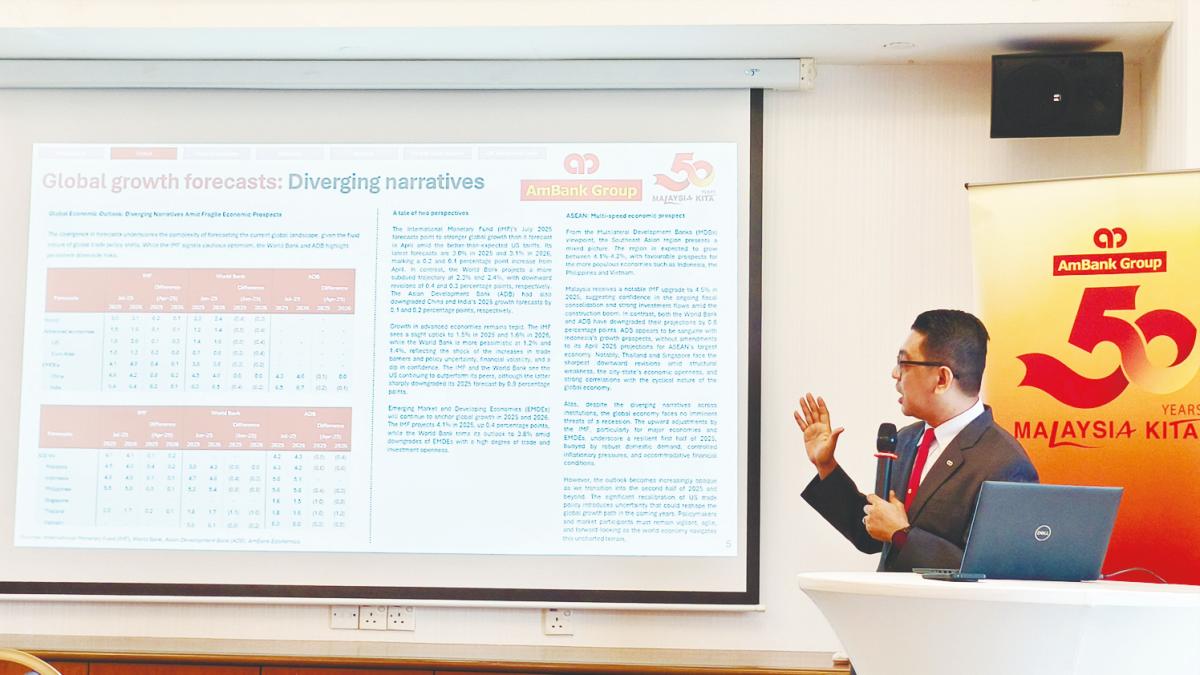KUALA LUMPUR: Malaysia’s economic growth outlook has tilted further to the downside as external shocks from US reciprocal tariffs and fragile domestic sentiment cloud the recovery.
AmBank Group chief economist Firdaos Rosli, in presenting the bank’s second-half macroeconomic outlook for Malaysia, said AmBank has maintained its 2025 gross domestic product (GDP) growth forecast at 3.8%, but cautioned that risks are increasing.
“Our exports are still highly concentrated in electronics and machinery, and the new reciprocal tariffs have added a layer of cost. At the same time, private consumption, while resilient on paper, is constrained by low capacity to spend,” he told reporters at a media briefing today.
Malaysia’s exports to the United States have fallen sharply since Washington imposed a 19% reciprocal tariff earlier this month.
AmBank estimates that 53.9% of Malaysia’s exports to the US are now affected, with only semiconductors, which account for roughly 46% of shipments, exempt for the time being.
“Electronics and machinery account for about 72% of Malaysia’s exports to the US. That concentration exposes us to both the global semiconductor cycle and tariff risks. If the US extends duties to semiconductors, the impact would be severe,” Firdaos said.
He added that while Malaysia remains more competitive than China in sectors such as rubber gloves, where tariffs on Chinese products remain higher, the broader rise in trade costs cannot be ignored.
“What exporters actually pay has jumped from around 3.4% in 2023 to 19% this year. This is a significant added layer of cost,” he noted.
Despite Malaysia’s tight labour market, with unemployment at 3% and wages rising, household spending has not picked up as strongly as expected.
Firdaos described this as a paradox: “By right, propensity to spend should be stable or higher, but loan applications and disbursements have tapered in recent months. That signals a low capacity to spend.”
AmBank projects private consumption growth of 5% for 2025, but Firdaos said the figure could be higher if confidence improves.
Government measures, such as the RM100 cash aid, may provide a temporary boost, but he characterised the move as a “policy experiment” rather than a game-changer.
Household debt, at 85% of GDP, remains elevated but is primarily tied to wealth-generating assets, such as housing, rather than depreciating assets like cars or credit cards.
“The concern should be on the bottom layers of debt, not the headline ratio,” Firdaos stressed.
Malaysia’s fiscal deficit is expected to narrow to 3.8% of GDP by year-end, providing the government with limited room to support the economy in the second half of 2025.
“This means the upcoming budget will likely be pro-growth, people-centric and gradual.
“We do not expect new broad-based taxes, though a carbon tax could be introduced in 2026,” Firdaos said, adding that the political mid-cycle and upcoming state elections would shape the government’s strategy.
He cautioned that the planned rationalisation of the RON95 fuel subsidy remains unclear, with implementation details still under discussion.
“Until we see the nuts and bolts, scepticism will remain. This government appears to be taking a more nuanced approach that goes beyond income, also to consider asset ownership and debt levels,” he observed.
Firdaos suggested that the government’s fiscal strategy would be shaped not only by economics but also by politics.
“Once we hit the midpoint of the political cycle, the remaining budgets will typically focus on being pro-people. That means reforms will be more gradual and calibrated, especially with state elections in Sabah, Sarawak and Johor on the horizon.”
Firdaos said China’s ability to sustain growth above 5% would help regional trade sentiment, but warned against expecting a major rebound spillover. “China’s strategy is still very export-driven and aggressive, especially in sectors like automobiles. If they remain stable, it provides some cushion, but Malaysia cannot rely on China alone to lift growth.”
Looking ahead, Firdaos emphasised that Malaysia’s growth outlook is skewed to the downside, with external conditions likely to remain volatile.
“The key challenge for businesses will be navigating higher trade costs and weaker global demand, while policymakers must balance fiscal consolidation with pro-growth spending. The second half of 2025 will test how resilient domestic demand really is,” he said.









